
Dentistry, also known as dental medicine and oral medicine, is the branch of medicine focused on the teeth, gums, and mouth. It consists of the study, diagnosis, prevention, management, and treatment of diseases, disorders, and conditions of the mouth, most commonly focused on dentition as well as the oral mucosa. Dentistry may also encompass other aspects of the craniofacial complex including the temporomandibular joint. The practitioner is called a dentist.

Radiography is an imaging technique using X-rays, gamma rays, or similar ionizing radiation and non-ionizing radiation to view the internal form of an object. Applications of radiography include medical and industrial radiography. Similar techniques are used in airport security,. To create an image in conventional radiography, a beam of X-rays is produced by an X-ray generator and it is projected towards the object. A certain amount of the X-rays or other radiation are absorbed by the object, dependent on the object's density and structural composition. The X-rays that pass through the object are captured behind the object by a detector. The generation of flat two-dimensional images by this technique is called projectional radiography. In computed tomography, an X-ray source and its associated detectors rotate around the subject, which itself moves through the conical X-ray beam produced. Any given point within the subject is crossed from many directions by many different beams at different times. Information regarding the attenuation of these beams is collated and subjected to computation to generate two-dimensional images on three planes which can be further processed to produce a three-dimensional image.
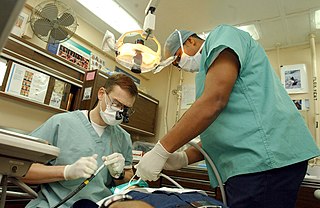
A dentist, also known as a dental surgeon, is a health care professional who specializes in dentistry, the branch of medicine focused on the teeth, gums, and mouth. The dentist's supporting team aids in providing oral health services. The dental team includes dental assistants, dental hygienists, dental technicians, and sometimes dental therapists.
The American Dental Association (ADA) is an American professional association established in 1859 which has more than 161,000 members. Based in the American Dental Association Building in the Near North Side of Chicago, the ADA is the world's largest and oldest national dental association and promotes good oral health to the public while representing the dental profession.
Oral and maxillofacial surgery is a surgical specialty focusing on reconstructive surgery of the face, facial trauma surgery, the oral cavity, head and neck, mouth, and jaws, as well as facial cosmetic surgery/facial plastic surgery including cleft lip and cleft palate surgery.

The Harvard School of Dental Medicine (HSDM) is the dental school of Harvard University. It is located in the Longwood Medical Area in Boston, Massachusetts. In addition to the DMD degree, HSDM offers specialty training programs, advanced training programs, and a PhD program through the Harvard Graduate School of Arts and Sciences. The program considers dentistry a specialty of medicine. Therefore, all students at HSDM experience dual citizenship between Harvard School of Dental Medicine and Harvard Medical School. Today, HSDM is the smallest school at Harvard University with a total student body of 280.
A number of professional degrees in dentistry are offered by dental schools in various countries around the world.

Lead shielding refers to the use of lead as a form of radiation protection to shield people or objects from radiation so as to reduce the effective dose. Lead can effectively attenuate certain kinds of radiation because of its high density and high atomic number; principally, it is effective at stopping gamma rays and x-rays.
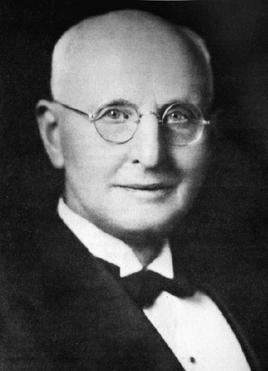
Weston Andrew Valleau Price was a Canadian dentist known primarily for his theories on the relationship between nutrition, dental health, and physical health. He founded the research institute National Dental Association, which became the research section of the American Dental Association, and was the NDA's chairman from 1914 to 1928.
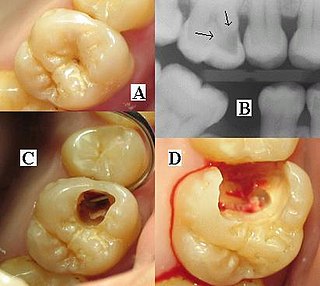
Dental radiographs, commonly known as X-rays, are radiographs used to diagnose hidden dental structures, malignant or benign masses, bone loss, and cavities.
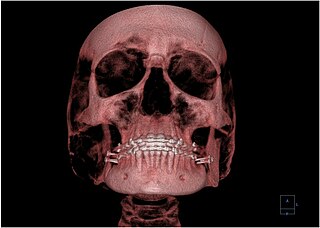
Oral and maxillofacial radiology, also known as dental and maxillofacial radiology, is the specialty of dentistry concerned with performance and interpretation of diagnostic imaging used for examining the craniofacial, dental and adjacent structures.
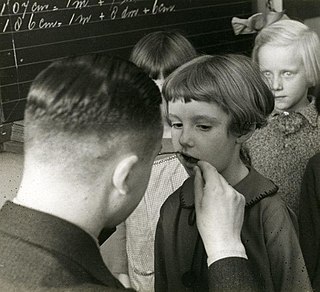
Pediatric dentistry is the branch of dentistry dealing with children from birth through adolescence. The specialty of pediatric dentistry is recognized by the American Dental Association, Royal College of Dentists of Canada, and Royal Australasian College of Dental Surgeons.
Vijay P. Parashar, BDS, MDS, DDS, is an oral and maxillofacial radiologist working as faculty at Midwestern University in Glendale, Arizona. Prior to joining Midwestern University as Associate Professor, Parashar was the Assistant Professor of Biomedical and Diagnostic Sciences at University of Detroit Mercy in Detroit, Michigan. Parashar won the 2006 Howard R. Raper and 2012 William H Rollins Oral and Maxillofacial Radiology Awards given by American Academy of Oral and Maxillofacial Radiology. Parashar received Doctor of Dental Surgery (DDS) from the University of Detroit Mercy School of Dentistry, Master of Dental Science from the University of Connecticut School of Dental Medicine, Certification in Oral and Maxillofacial Radiology from the University of Connecticut School of Dental Medicine and Bachelor of Dental Surgery from Manipal College of Dental Sciences, Manipal. Parashar is on the scientific editorial board of peer-reviewed journals such as Journal of Oral Health and Community, India Dentistry, International Journal of Oral Implantology and Clinical Research, India, and American Journal of Esthetic Dentistry, USA. Parashar's positions with ADEA include,: Chair 2010 – 2011, Oral & Maxillofacial Radiology Section, Chair-elect 2009 – 2010, Oral & Maxillofacial Radiology Section and Secretary 2008 – 2009, Oral & Maxillofacial Radiology Section. Parashar is currently serving on the ADA Commission on Dental Accreditation (CODA) Oral Radiology Review Committee; ADEA Council of Faculties; National Board Dental Test Construction Committee and is a CODA Site Visitor.
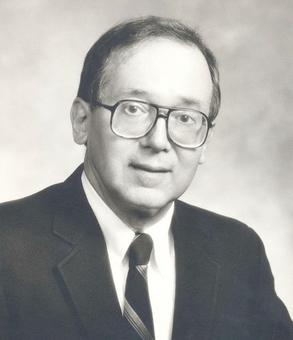
John Miller Hyson, Jr. was the former curator, director of curatorial services, and director of archives and history at the National Museum of Dentistry, an affiliate of the Smithsonian Institution located in Baltimore, Maryland. He was also the author of many articles and books on the history of dentistry and was a practicing dentist for nearly 50 years.
In the United States and Canada, there are twelve recognized dental specialties in which some dentists choose to train and practice, in addition to or instead of general dentistry. In the United Kingdom and Australia, there are thirteen.

A panoramic radiograph is a panoramic scanning dental X-ray of the upper and lower jaw. It shows a two-dimensional view of a half-circle from ear to ear. Panoramic radiography is a form of focal plane tomography; thus, images of multiple planes are taken to make up the composite panoramic image, where the maxilla and mandible are in the focal trough and the structures that are superficial and deep to the trough are blurred.

Cone beam computed tomography is a medical imaging technique consisting of X-ray computed tomography where the X-rays are divergent, forming a cone.
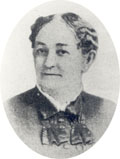
There is a long history of women in dentistry in the United States.
Christoffel Nortje is a South African dentist who is emeritus professor of oral and maxillofacial radiology at the Department of Diagnostics and Radiology at the University of the Western Cape, Faculty of Dentistry in Cape Town, South Africa. He was in private practice prior to joining the Department of Diagnostics and Radiology at Stellenbosch University, where he headed the department until 2005.

Clarence Edmund Kells Jr. (1856–1928) was an American dentist and inventor who is sometimes described as "the father of dental radiography". He practiced dentistry in New Orleans for 50 years and held about 30 patents for dental and electrical devices. He introduced a suction apparatus for use by both dentists and surgeons, took some of the earliest X-rays of the teeth of live patients, hired the first female dental assistant, and had one of the first dental offices with electricity.













